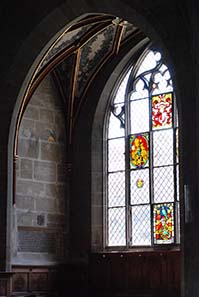Every tourist visiting one of the big cathedrals cannot miss them: the small family chapels surrounding the high altar. Being lavishly adorned with beautiful works of art they are often more attractive than the high altar. People in Medieval and early Modern Times set up such jewels of Christian art for practical reasons as well. In such a family chapel the owners had Masses read for their soul’s salvation; Masses that were supposed to diminish significantly the time spent in purgatory. Of course, that means of advancing the salvation of one’s soul was available only to the richest citizens of a town. But what was the price for such a side chapel, what did the support of a priest and the liturgical equipment cost? In short, what was the price – in Rhenish gulden of the early 15th century – for the salvation of the soul?
View inside the chapel of the Diesbach family in the Bernese Cathedral. Photograph: Markus Beyeler.
In the catalogue accompanying the exhibition Bildersturm, Wahnsinn oder Gottes Wille, Peter Jezler has assembled the costs for a real existing chapel. He accessed archival materials and calculated how many gulden the family chapel of the Diesbach family in the Bernese Cathedral cost in those days.
First, the structural work had to be purchased. The shed of the Bernese Cathedral had built the structural work of the main as well as the side aisle in conjunction with the chapels. To finance the building at least partly, the building authority sold those chapels to donors. For the buying price, the sky was the limit. Depending on how much the buyer wanted to share also the general building costs the price varied. The Diesbach family spent 800 gold gulden on their chapel in 1442, which was quite a sum. Roughly ten years earlier, in 1430, Peter Matter paid only 200 gold gulden for another side chapel.
But not all expenses were covered with that. The Diesbach family had to benefice a priest for providing his service for an unlimited period. The foundation capital was 1000 gulden – with a yearly interest rate of 5 % that was an “annual salary” of 50 gulden for the priest who was required to read five Masses every week in turn. In addition he was provided with a priest’s residence as city apartment with an additional cost of 240 gulden for the Diesbach family.
Present-day glass window in the Diesbach family chapel in the Bernese Cathedral. Photograph: Markus Beyeler.
Not only the structural work and the foundation capital had to be procured but the money for the chapel’s proper fitout as well. At first, the vault was not finished. With regard to the Diesbach chapel there are no specific numbers at hand but a comparable vault of a side chapel cost 33 gulden in Bern in 1451. The cost of the expensive glass windows can only be guessed, too. The Window of 10.000 Knights in the Cathedral of Bern, which was approximately 2.5 times the size of the window of the Diesbach chapel, was funded with donations worth 180 gulden. In addition, commodity contributions were made, like four silver bowls and sheets of paper for the draft. All in all, the window of the Diesbach chapel might have cost 50 to 100 gulden. There were additional costs for the altar retable in the shape of a winged altar, the Eucharistic vestments, the pews, the chalice and other liturgical equipment, the antependium (= a lavishly embroidered cloth hanging in front of the altar), the altar cloth, the missal and all further objects necessary to embellish the chapel and to read the Holy Mass.
When toting up the figures, the Diesbach chapel cost 2500 gulden consisting of the following articles:
|
structural work of the chapel A total of:
|
800 fl c. 300 fl c. 2500 fl |
In sum, the Diesbach family paid 2500 gulden for their chapel. They could have bought 10 town houses built of stone from that money. Hence, an enormous sum had been invested in that divine foundation. The chapel’s owners on their part were sure to have struck a bargain. Five times a week, until doomsday, the Requiem Mass was read to make the time spent in purgatory pass more quickly. However, there were only 86 years left until “doomsday”. On January 26th, 1528, iconoclasm began in the Bernese Cathedral and all the privileges the Diesbach family had heavily paid for became obsolete.
I am heavily indebted to Markus Beyeler, a “coin friend” from Bern, for providing photographs as illustrations for this article in record time. Without friends like him scattered all over the world CoinsWeekly would not be possible!





